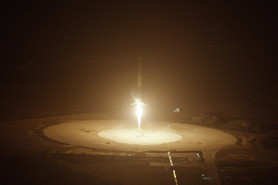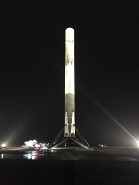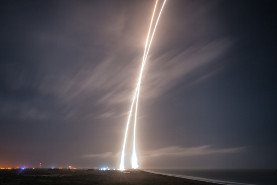|
|
Why send humans to space?
The following are two old reasons but lately it seems more and
more people are thinking of them:
- a backup civilization, in case we blow it down here on Earth,
- a source of rescue, in case we need it down here on Earth.
Path to space
April 16, 2016 - Bigelow's inflatable BEAM attached to the International Space Station
|
Bigelow Aerospace's inflatable habitat, called BEAM for Bigelow
Expandable Activity Module, was successfully attached to the
International Space Station (ISS). It was removed from the trunk of
SpaceX's Dragon spaceship, the cylindrical section behind the
capsule, using the ISS's CanadaArm 2 robotic arm and then attached
to the Tranquility module.
The habitat will be inflated sometime in May due to the astronaut's
already busy schedule. It will remain on the ISS for 2 years while
it undergoes testing for radiation, meteorites and be entered
by astronauts several times a year.
|
Credit: NASA TV
 |
|
|
April 8, 2016 - SpaceX lands 1st stage of oribital rocket on ship
|
SpaceX once again made history, this time by landing the 1st stage
of their Falcon 9 orbital rocket on their droneship, "Of Course I Still
Love You" on the ocean. This is significant as for many of their
flights the 1st stage will be going too fast and not have enough
fuel to return back to Florida to land. It'll instead land on a
droneship in the Atlantic Ocean and then be returned to land for
refurbishing and relaunch. Elon Musk has said that they'll attempt
to relaunch this booster.
|
Image: SpaceX
 |
|
|
December 21, 2015 - SpaceX lands 1st stage of oribital rocket on ground
SpaceX made history by launching a rocket with a payload to orbit and
landing the 15-storey high 1st stage of the rocket back to a landing
site near to where it was launched. This was no up to the edge of space
and back down as Blue Origin did the month before (see news item
immediately below), though that was still a historic first for different
reasons.
In this case
SpaceX launched 11 ORBCOMM satellites to orbit at the same time.
After a few minutes into flight, the 2nd stage
separated from the 1st and continued to orbit, and after deploying the
payload, then burned up on reentry. Different from any other
rocket in history, after separation at a height of 125 miles (200 kilometers)
the 1st stage did a boost back burn
to turn the rocket around and head back to the landing pad. As the
1st stage rentered the atmosphere it did a reentry burn to slow down.
Then a final single engine burn was done for a soft touchdown
on a 282 foot diameter, reinforced concrete landing pad
within 1000 feet of the processing area which is about six miles
from the launch pad.
Landing was at 9 minutes and 44 seconds after launch. Landing within
1000 feet of the processing area means the 1st stage would have to be
moved only that distance for reprocessing and then reuse on a subsequent
mission.
SpaceX had previously attempted landing on a drone ship out to sea
and should a future mission require landing down range of the launch area
then the drone ship will still be used.
Below is a video of the landing. The full mission video is viewable
here.
November 23, 2015 - Blue Origin successfully lands from suborbital flight to space
|
On November 23, 2015,
Blue Origin
launched their rocket to a planned test altitude of 100.5 kilometers,
or 329,839 feet, and softly landed it again on a predetermined landing
pad. 100 kilometers is the internationally recognized edge of space.
At the same time a capsule which will one day carry people detached
and landed using three parachutes.
Note that this was a suborbital flight and that this rocket would not
be capable of launching either cargo or people to orbit, though it is
Blue Origin's plan to one day do so. This is the first time a rocket
has launched vertically to the edge of space and then vertically landed.
This rocket is a major step to
Blue Origin providing a suborbital service, carrying passengers to the
edge of space for 4 minutes of microgravity and a view of the
Earth from space.
|
Source: Blue Origin
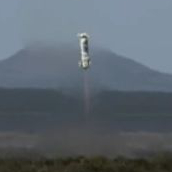 |
|
|
Note that in the following video the rocket take-off, capsule landing
and rocket landing are all real. An animation has been added of
passengers in space which has not yet happened in reality and was not
a part of this flight.
October 7, 2015 - SpaceIL has verified launch contract for Google Lunar XPRIZE mission
|
SpaceIL,
an Israeli non-profit organization, has announced they
have a verified launch contract for launching their spacecraft to
the moon in the second half of 2017. SpaceIL purchased the launch
services from Spacecraft Industries who purchased the SpaceX Falcon 9
rocket to be used for the launch. This meets the
Google Lunar
XPRIZE (GLXP) requirement that a competitor have a verified launch
contract before the end of 2015 in order for the overall contest
deadline to be extended to December 31, 2017, giving all competitors
more time. GLXP has announced that the deadline has been extended.
|
Courtesy of SpaceIL
 |
|
|
July 18, 2015 - Planetary Resources Inc. deploys its first spacecraft
|
On July 16, 2015,
Planetary Resources'
first spacecraft, the Arkyd 3 Reflight (A3R), was deployed from the
International Space Station (ISS) for a 90 day mission. It was carried
as payload to the ISS on Spacex's
CRS-6 mission. The word "Reflight" is in its name due
to an earlier attempt to launch the Arkyd 3 to space failed when the
Orbital System Corp's
Antares rocket that exploded during launch back in October 2014 (see the
November 2014 news bites below.)
The spacecraft will test various core technologies to be used on future
missions such as avionics, control systems and software for near-Earth
asteroid prospecting.
In the photos on the right you can see the A3R being deployed along with
an unrelated Cube Sat.
|
Courtesy of NASA
 |
|
Courtesy of NASA
 |
|
|
May 3, 2015 - Blue Origin successfully launches New Shepard to the edge of space
|
On April 29, 2015,
Blue Origin
flew their first developmental test flight of their New Shepard space
vehicle to a height of 307,000 feet or 93.57 kilometers, just shy of
the 328,084 foot or 100 kilometer mark, the officially selected height
at which space begins. This is their suborbital vehicle, one which
will provide passengers and scientific payload a few minutes of
microgravity before returning to Earth. During their test the capsule
succcessfully returned to Earth for a soft landing with the help of
three parachutes.
|
Source: Blue Origin
 |
|
|
April 8, 2015 - Ad Astra gets funding for next generation of VASIMR rocket
|
On March 31, 2015, NASA awards Ad Astra approximately $10 million
over three years as part of NASA's NextStep program to advance the
VASIMR rocket engine
to technology readiness 5, a step closer to getting it ready for space
travel. The VASIMR rocket is an ion engine capable of much higher
thrust than other ion engines that could potentially someday
shorten a crewed trip to Mars to just 39 days. The new rocket will
be designated VX-200-SS (the SS stands for Steady State) and will
be a fully integrated system capable of thrusting at high power
continuously for a minimum of 100 hours.
|
Source: NASA
 |
|
|
March 23, 2015 - News bites...
Mars One
announced
that due to a delay in paperwork for a large funding deal with a
consortium of investors, they won't be in time to finance a follow-up
study by Lockheed Martin in preparation for a previously planned unmanned
mission to Mars in 2018, delaying it to 2020. This pushes back all
the milestone dates by 2 years each, resulting in the planned landing
of the first crew to Mars now being in 2027.
|
Elon Musk, CEO of SpaceX,
recently tweeted this photo of a landing
platform for landing their rockets out to sea for recovery and
reuse. In his
tweet he said "Autonomous spaceport drone ship. Thrusters
repurposed from deep sea oil rigs hold position within 3m [10ft] even in a
storm." The platform's surface is 91m x 30m (300ft x 100ft) and wings
extend the width to 50m (170ft). In future the platform will have
refueling capability added so that the 1st stage rocket can be refueled
to fly back to the launch site for reuse.
|
Image: SpaceX
 |
|
|
Bigelow Aerospace has
been waiting for years for the development of a space transportation
system to carry people to and from its planned inflatable orbiting
space station. With the
progress of SpaceX with its
Dragon space capsule and Falcon 9 rockets, and
Boeing with its CST-100 space
capsule, it looks like Bigelow is preparing to take the next step,
judging by their having recently posted 100 job positions on
their website.
|
Planetary Resources,
a company with solid plans to do asteroid mining, was recently sending its
first technology and system test platform called the Arkyd3 to space
(see photos on the right.)
Unfortunately it was a passenger on Orbital System Corp's Antares rocket
that was exploded just short of getting off the launchpad on
October 28, 2014. Planetary Resources
said that such events are planned for and that it does not affect
their schedule or budget. Their next test vehicle, the Arkyd 6, is planned
for Q3 2015.
|
Image: Planetary Resources
 |
|
Image: Planetary Resources
 |
|
|
|
NASA recently did
the first 3D printing in space on the International
Space Station using a printer made by Made in Space, Inc., a space
manufacturing company. The objective is to demonstrate that 3D
printing works in a zero-gravity environment. The printer is designed
to be controlled from the ground, limiting the astronauts' involvement
to save them time. Test parts will be returned to Earth where
identical printing is being done and the parts can be compared.
|
Source: NASA
 |
|
|
September 16, 2014 - SpaceX and Boeing win contract to carry crew to/from the ISS
|
NASA announced that SpaceX
with its Dragon spacecraft and
Boeing with its CST-100
spacecraft have won the contract to carry crew to and from the ISS
by 2017.
Sierra Nevada Corporation
with its Dream Chaser, the third contendor, did not win a contract.
The contract is worth $2.6 billion for SpaceX and $4.2 billion for
Boeing over several years. Each company will first perform one test
flight to include at least one NASA astronaut to verify that the
system can launch, maneuver in rbit, dock to the space station, and
validate that all systems perform as expected. After that each company
will do at least two missions to the ISS and as many as six. The
spacecraft will also act as lifeboat while there.
|
Image: SpaceX
 |
|
Image: Boeing
 |
|
|
|
Lockheed-Martin and Surrey Satellite Technoology Ltd. (SSTL) were
contracted by Mars One to develop mission concept studies for a
2018 demonstration mission to Mars in preparation for the 2025
manned mission. The study by Lockheed-Martin will be for a lander with
proof-of-concept technologies important for human habitation including
producing liquid water from water in the Mars soil and testing
various thin film solar technologies. The study by SSTL is for a
communications satelite to be sent to near geosynchronous orbit for
24/7 communication between Earth and Mars except when the sun is
between the two planets. It will relay image, video and other data
with a bandwidth 4 times that of the NASA Mars Reconnaissance Orbiter.
The 2018 mission date is two years later than the original schedule
causing all subsequent dates to be pushed ahead by two years
meaning the new date for landing of the first crew on Mars will
be 2025 instead of 2023. This is in order to allow time for
develoment of the 2018 mission's spacecraft, for time to find
subcontractors for the lander's experiments and to organize a
number of competitions for these missions.
Click here for
more details.
|
Bryan Versteeg/Mars One Foundation
 |
|
|
April 22, 2013 - Mars One astronaut selection process begins
|
The selection process for the astronauts to settle Mars as part of
the Mars One plan has begun. This is a one-way trip to settle Mars,
the first group of four settler to arrive in 2023. Click
here for
more details.
|
Mars One/Bryan Versteeg
 |
|
|
|
Bigelow Aerospace
and NASA have announced that Bigelow will provide a new habitable
module called BEAM (Bigelow Expandable Activity Module) for attaching
to the International Space Station (ISS) for $17.8 million dollars
around the summer of 2015.
Unlike the current modules on the ISS,
which are all basically metal cans, this will be an inflatable one.
It'll ride a rocket up from Earth compressed in a 7 foot
tube and then be inflated to 13 feet long and 10 feet in diameter.
From the artists impression shown at right, it will be attached to
the ISS's Tranquility Node.
It'll have a volume of just 560 cubic feet or around 16 cubic
meters, much smaller than Bigelow's planned inflatable BA330
modules with volumes of 330 cubic meters. However, it will be
habitable by the astronauts, who may even choose to sleep there
on occasion as it's expected to be much quieter than the rest of
the ISS. Proving its habilability will aid Bigelow in their
business plans for their own space station Alpha.
|
Bigelow Aerospace LLC
 |
|
Bigelow Aerospace LLC
 |
|
|
|
At 12:02AM Eastern time today SpaceX's
Dragon spacecraft successfully berthed (was docked), at the
International Space Station (ISS), at the time orbiting
250 kilometers about the Earth. It was berthed to the Earth-facing
port of the station's Harmony module. This was the first commercial
spacecraft to visit the station and the first US spacecraft to do so
since the space shuttle Atlantis in July 2011.
The Dragon was launched on a Falcon 9 rocket on May 22
and spent May 23 travelling toward the ISS. It spent May 24 doing
various maneuvering tests, approaching as close as 1.5 kilometers
from the station. At 9:56AM eastern time on May 25th, Don Petit, a US
astronaut aboard the station successfully grappled the Dragon with
a 58 meter long manipulator arm and by around 12:02AM, berthing
of the Dragon to the station was complete. This was followed by
bolting of the craft to the station and then pressure checks to
make sure there were no leaks. After that the air pressure in
the Dragon will be equalized to that of the station so that the
hatch could be opened, expected to happen the mornining of May 26th.
At one point during approach the Dragon's LIDAR (LIght Detection
And Ranging) system ran into a problem. It was picking up a reflection
from a reflector on the Japanese Kibo module, one of three modules
permanently connected to the Harmony module. From it's control
center in Hawthorne, Texas, SpaceX narrowed the viewing aperture of
the LIDAR system so that the reflector was no
longer in its view and the approach continued without further
issue.
The Dragon is delivering a little more than 1000 pounds of cargo
including food, cargo bags, computers, and more, and will be
returning a little more than 1300 pounds back to Earth. The Russian
Soyuz spacecraft is the only other craft capable of returning cargo to
Earth, however it's intended for crew and remaining room for cargo
is about the size of a backpack. The Russian Progress, the European
ATV and the Japanese HTV are designed only to burn up on reentry.
The Dragon will remain berthed at the station for approximately
2 weeks and on May 31st will return to Earth, splashing down in the
Pacific a few hundred miles west of Southern California.
|
May 22 photos courtesy SpaceX
May 25 photos courtesy NASA
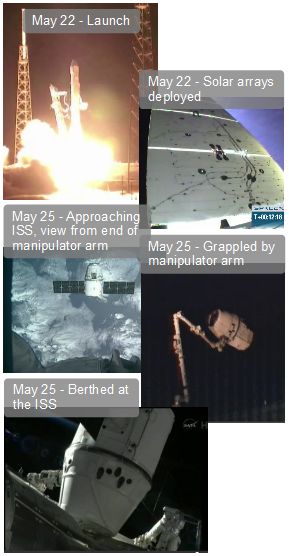 |
|
|
May 10, 2012 - SpaceX and Bigelow to conduct joint marketing
|
SpaceX and
Bigelow Aerospace
have announced plans to conduct joint marketing focused on
international customers. SpaceX will use its Falcon 9 rocket and
Dragon spacecraft to carry passengers to Bigelow's space habitats.
At this time SpaceX's Falcon 9 has successfully launched twice
and will be attempting its first cargo run to/from the ISS,
currently scheduled for May 19th.
Passenger capability is expected within a few years. Bigelow Aerospace
has already launched two small scale test habitats and is awaiting
the development of passenger-carrying spacecraft before sending up
three fullscale BA330 inflatable habitats to make up a space station.
Bigelow has been partnering with Boeing and helping with development
of their CST-100 spacecraft. With SpaceX, that now makes two future
spacecraft to rely on.
|
|
|
Image: SpaceX
 |
|
|
April 27, 2012 - Planetary Resources to do asteroid prospecting and mining
|
Peter Diamandis, founder of the X Prize, has announced the existence
of his company Planetary Resources which is working towards prospecting
and mining near Earth asteroids, first for water and then for
platinum. The first spacecraft, the Arkyd 100 series space telescope,
will launch by 2014 to begin cataloging suitable asteroids. Click
here for
more details about Planetary Resources' plans.
|
Image: Planetary Resources
 |
|
|
For older news see space news archive
page.
|





